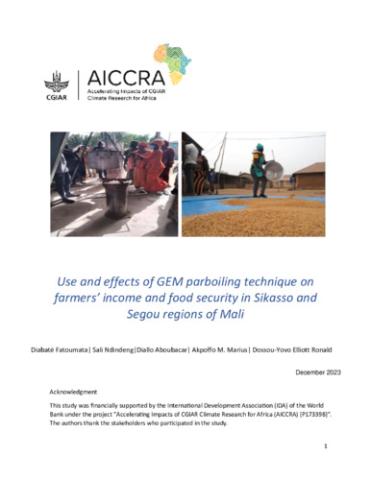Abstract
Fortifying rice using parboiling has been shown to have a higher retention rate of nutrients and improve the physical and nutritional quality of rice. Recently, the Grain quality enhancer, Energy-efficient and durable Material (GEM)’ developed by Africa Rice Center was introduced in Mali in the framework of the implementation of the World-Bank funded project ‘Accelerating Impacts of CGIAR Climate Research for Africa (AICCRA)’. Since then, several initiatives were taken for the large-scale dissemination of the GEM parboiling technique. However, no information is available of the relative performance of the GEM parboiling to the existing parboiling techniques. This study assessed the use and effects of the GEM technique on parboiling performance, as well as the income and food security status of parboilers in Mali. An inventory of GEM parboiler users was conducted, followed by a random sampling of 120 parboilers, including 30 using the traditional parboiling technique, 30 using GEM, and 30 using a parboiling kit. The results showed that the traditional parboiling method leads to a higher percentage of burnt and chalky grains compared to GEM technology and parboiling kits. Conversely, GEM parboiling technology and parboiling kits yield higher rates of whole rice compared to the traditional method, indicating that rice parboiled with GEM technology and the parboiling kit exhibit superior quality. GEM parboiling also requires less time compared to the traditional method and the kit parboiling technique. The revenue generated by the parboiling activity was notably higher with the GEM parboiling method compared to both parboiling kits and the traditional method. Furthermore, the percentage of residents in a food-secure situation was higher when employing GEM and Kits technologies compared to the traditional parboiling method. In conclusion, the GEM method enhances the quality of rice grains and increases the beneficiaries' income and their food consumption score.

